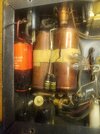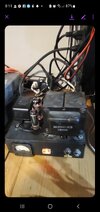Hi there, I have this modulator that is alot like a JB12 that I am working on and recapping after opening the unit up I noticed that there is a pair of old camera batteries 22 1/2 volt that are being used for the negative bias LOL, I also noticed there is only 4 wires coming from the transformer and not 6 wires like the Wawasee's so with this being said is there any easy way around this can I come off from somewhere else to put my bias circuitry in safely? I find multiple places that have around 50 VAC but they are going other places. Thanks




